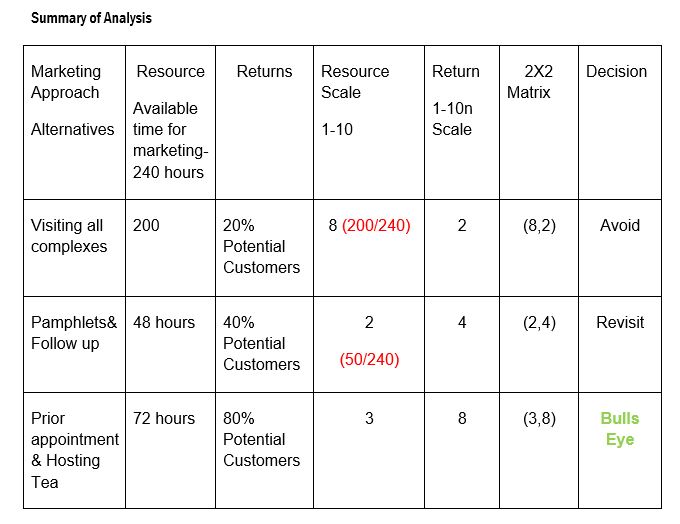Low Cost Customer Acquisition
A CASE STUDY

A low cost customer acquisition strategy is the need of all startups as their cash resources are limited.
“Without planning, even the most effective marketing will fail to deliver results.”- Ian Brodie- Marketing Thought Leader 2013
Sara opened a pre- school and was anxious to start admission process. She had spent a lot of her time trying to identify the right sources for customer acquisition but with little success. Sara, being a homemaker had very little personal savings. She could afford a maximum of $ 500 for her startup.
She had to start the school during that academic
session and was wondering what should be her strategy to acquire customers at low cost.
Low Cost Customer Acquisition- Fishing Holes
Sara’s school is in a metro town and is close to ten high rise apartments. Her analysis showed that there are close to 3000 families living in these high rise apartments. Most of the occupants were young working couples.
Low Cost Customer Acquisition - Resources vs-Return
Sara listed her resources and estimated the returns for each approach so that she can plot the Resources- Return matrix to identify potential customers.
Time 60 hours / week (50 hours for marketing)
Money: $500 budget for pamphlets/ high tea/ travel cost
Since her time is critical she evaluated all the alternatives to select one which will get her more customers per hour of work. She had limited cash resources whereas she had more time to spend on marketing.
The rating scale for both the resources and the returns was from 1-10, one being the lowest and 10, the highest. For return higher score is ideal whereas the lower score is the preferred option for resources..
Low Cost Customer Acquisition - Alternative Lead generations
- Meet individual families in high rise apartments
2. Enclose pamphlets in newspapers by tying up with vendors who supply daily news papers to residential complexes. Respond to potential clients by calling them.
3.Meet the office bearers of the 10 high rise apartment associations and request them to organize a meeting of residents on any weekend. She offer to host tea.
Resources -Return estimate for each alternative
Alternative1
Resource: Time
4 visits / complex and 5 hours in each complex which include follow up with interested customers .Time per residential complex: 4X5= 20 Hours
Total time for all ten complexes: 10X 20= 200 Hours ( 4 weeks)
Cash Resource; Travel Cost & Pamphlet
$ 5 / Complex Total $50
Return: Lead Generation
Based on a pilot, she realized she could meet only 20 % of the residents and all of them may not be her potential clients.
Time requirement: 200/ 240 - 80% which is a score of 8 out of ten for resources
Return: 20% success rate for identifying customers hence the score is 2 out of 10.
2X2 Matrix (Resource: Return) : (8,2)
Alternative2
Resource: Time
Inserting pamphlets in newspapers delivered to high rise building
Time required for arranging with vendors- She had to meet 6 vendors and withtravel time it would take her 24 hours to finalize with vendors. She had to respond to those who contacted her and she spend another 6 hours / week on this. For four weeks, the total time required was 24 hours.
Total Time resource for 4 weeks; 24+24= 48 hours. (48/ 240- 0.2 )
Return: Based on her discussion with vendors and friends she arrived at the figure of 40% success rate in potential clients contacting her. Thus the score is 4 out of 10
2X2 Matrix (Resource: Return) : (2,4 )
Cash Requirement
Pamphlet – 3000 numbers at 2 cents/ pamphlet 60$
Vendor Charges: 5 cents/ house- 150 $
Total 210 $
Alternative 3:
Resources: Time
Pre arrangement with each building Society: 2 hours (10X2)= -20 hours
Meeting day- 3 hours/ society (10X3) = 30 Hours
Follow up 20 hours
Total: 70 Hours
Resource: (70/240=0.3)
Return:
Based on meeting 20 families / society she would potentially meet 200 families.
Since Sara’s interest was only parents with young children her conversion rate would be 80 %
Thus the score is 8 out of 10
2X2 Matrix (Resource: Return) : (3,8 )
Expected Expenses: $ 300
The cash requirements for all alternatives are below the budget of $ 500.

Low Cost Customer Acquisition- Result
Alternative 3 was the lowest cost incurred per customer acquired. Sara invested less time but got higher returns by identifying the right fishing hole.
Low Cost Customer Acquisition- Conclusion
https://www.forbes.com/sites/steveolenski/2017/01/09/how-marketers-can-reduce-customer-acquisition-cost/2/#1431ebd84b35
A simple data driven approach can help startup entrepreneurs to validate their assumptions instead of using gut feel for decision making.

